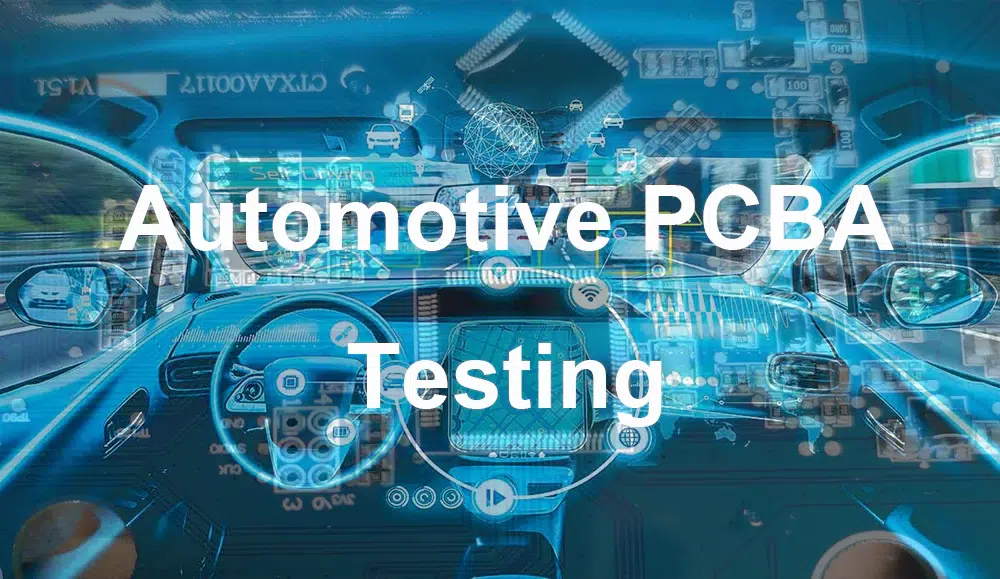With the development of automotive electronics and intelligence, automotive PCBA (printed circuit board assembly), as one of the core components of automotive electronics, has received more and more attention in its reliability testing. This article mainly discusses the specifications of automotive PCBA test , including test procedures and standards.
The definition and importance of automotive PCB board
Automotive PCB board refers to the printed circuit board used in automotive electronic systems, which carries the signal transmission and power supply functions of automotive electronic equipment. PCB in automotive electronics is mainly included in four major systems : power control system, safety control system, body electronic system, and entertainment communication.
The quality of the automotive PCB is directly related to the reliability and stability of the automotive electronic system, and has an important impact on the performance and safety of the car. Therefore, it is very important to improve the quality awareness of automotive PCBs.

The elements that affect the quality of automotive PCB
1. Design elements: The design elements of automotive PCB boards include PCB layout, line width and line spacing, impedance control, etc. Reasonable design can improve the stability and reliability of the circuit.
2. Material elements: The material elements of automotive PCBs include substrate materials, conductive materials, impedance materials, etc. Choosing the right material can improve the high temperature resistance, humidity resistance and corrosion resistance of the PCB automotive board.
3. Manufacturing elements: The manufacturing elements of automotive PCB boards include process flow, equipment, operating specifications, etc. Strict manufacturing requirements can guarantee the consistency and stability of PCB automotive boards.
4.Test elements: The test elements of PCB automotive board include electrical test, reliability test, environmental adaptability test, etc. Comprehensive testing can ensure the quality and reliability of PCB automotive boards.
The basic process of PCBA testing
1. Preparation before the test: including preparing test equipment and tools, building a test environment, etc.
2. Functional test: Test each functional module of PCBA to ensure its normal operation.
3. Performance test: test the performance of PCBA, including electrical parameters, mechanical parameters, etc.
4. Reliability test: test the reliability index of PCBA, including reliability, longevity, anti-interference ability, etc.
Inspection steps and methods
1. Appearance inspection: check PCBA soldering quality, component installation quality, etc.
2. Electrical parameter test: The current, voltage, power and other parameters of PCBA are tested by testing instruments.
3. Mechanical performance test: including the anti-vibration performance and impact resistance performance of PCBA.
4. Environmental performance test: Test the working conditions of PCBA under various environmental conditions, such as temperature and humidity.
5. Test of reliability: test the life and MTBF of PCBA according to relevant standards.

Relevant test standards
1. ISO 16750-3: Reliability test standard for automotive electrical equipment.
2. AEC-Q100: Guidelines for Reliability Testing of Automotive Electronic Components.
3. JEDEC JESD22-B102: Semiconductor device reliability test method.
reporting of test results
1. Evaluate the reliability level of PCBA according to the test results and compare with the standard.
2. Prepare a test report to record the test process, test results and evaluation.
Conclusion
The automotive electronics has always been the third largest application field of PCB after computers and communications. As automobiles have gradually evolved from mechanical products in the traditional sense to high-tech products with intelligence, informationization, and mechatronics, electronic technology has been widely used in automobiles, whether it is engine systems, chassis systems, Control system, security system, information system, in-vehicle environment system, etc. all use electronic technology products without exception. Automotive electronics has obviously become a focus, and the development of automotive electronics has naturally led to the development of automotive PCBs.
Automotive PCBA testing is a key link to ensure the normal operation of automotive electronic equipment. The PCBA testing can be effectively improved through reasonable testing procedures and standards. However, the relevant standards still need to be further improved and updated. In the future, it is necessary to strengthen the research and specification formulation of automitive PCBA testing to meet the increasingly complex and changing needs of automotive electronic equipment.










